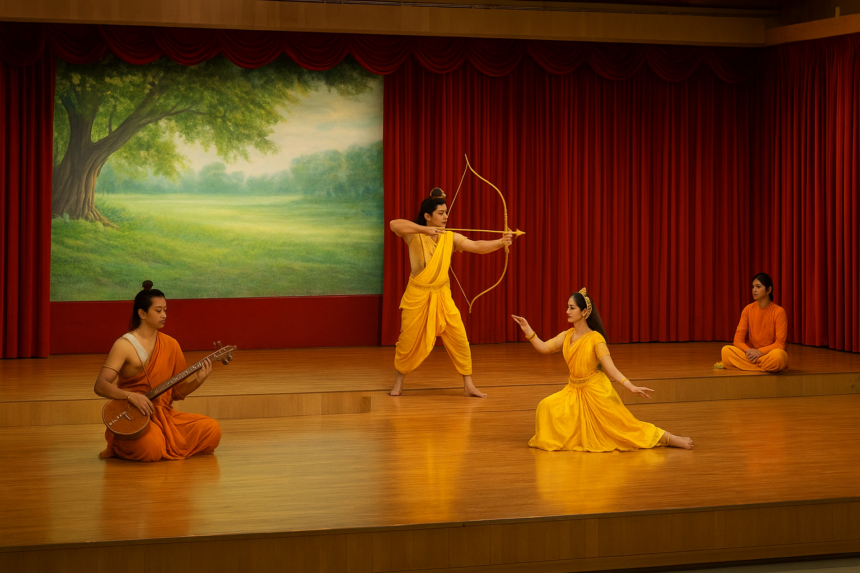Ramayana Performed in Chinese Language: A Cultural Bridge Between India and China
The ancient Indian epic Ramayana has once again crossed borders, this time captivating audiences in Beijing, but with a unique twist. The timeless tale of Lord Rama, Sita, and Ravana was performed entirely in the Chinese language, bringing together two great civilizations through the art of storytelling and performance.
This grand event took place at the Indian Cultural Center in Beijing, drawing both Indian and Chinese spectators. The performance, which featured Chinese artists, showcased how art can beautifully transcend linguistic and cultural boundaries. The adaptation was not just a theatrical performance, it was a heartfelt cultural dialogue that blended India’s spiritual heritage with China’s artistic expression.
The Unique Chinese Interpretation of Ramayana
This adaptation of the Ramayana stood out for its creative choreography and presentation. The performance integrated traditional Chinese stage elements, such as elegant costumes, symbolic gestures, and the rhythmic grace of Chinese opera movements. Every scene was carefully designed to reflect both Indian mythology and Chinese aesthetics.
From the battle between Rama and Ravana to the devotion of Hanuman, every sequence was delivered with emotion and precision. Chinese actors spent months studying the Indian epic and learning its moral depth. Translating the dialogues into Mandarin wasn’t just about language, it was about understanding the values of dharma, loyalty, and righteousness that the Ramayana embodies.
The Story Behind the Cultural Collaboration
The initiative was jointly supported by the Indian Embassy in China and Chinese cultural institutions, marking a milestone in cultural exchange. The goal was to strengthen the friendship between India and China by reviving ancient stories that promote shared human values.
Over 50 Chinese performers participated in this grand production, including dancers, musicians, and stage designers. Their dedication reflected how the Ramayana’s universal message continues to resonate beyond India’s borders. The production team worked closely with Indian cultural experts to ensure the story stayed true to its spiritual roots, while also allowing space for Chinese artistic interpretation.
Bringing the Ramayana to Life on a Chinese Stage
The stage came alive with vivid lighting, grand backdrops, and classical music that combined Indian instruments with Chinese melodies. The opening scene introduced Lord Rama and his companions, portrayed in flowing Chinese costumes yet maintaining the essence of Indian attire. The transition from Ayodhya to Lanka was expressed through stunning visual projections and synchronized dance movements.
What made this performance even more special was the fusion of cultures. For instance, the movements of the monkeys in Hanuman’s army incorporated traditional Chinese martial arts choreography, while Sita’s scenes included soft, graceful dance inspired by Chinese classical performance traditions. The combination created a harmonious balance between the two nations’ storytelling styles.
Audience Reaction: Emotional and Proud
The audience’s response was overwhelming. Both Indian expats and Chinese locals were seen applauding the performance with deep admiration. Many expressed that they were touched by how the Ramayana’s story could be told so beautifully in a foreign language without losing its essence.
Chinese spectators shared that they were amazed by the moral depth of the story, which echoed values found in Chinese legends such as loyalty, family, and virtue. Indian visitors felt emotional pride watching their country’s treasured epic performed with such respect and creativity on a foreign stage.
Why Ramayana in Chinese Matters
The Ramayana’s presentation in Chinese is more than just an artistic achievement—it’s a symbol of cultural unity. In today’s world, where nations often differ in politics and ideology, such artistic exchanges remind us of our shared human spirit.
By performing the Ramayana in Chinese, artists have opened a new path for cross-cultural understanding. It shows how India’s ancient wisdom and China’s timeless art can merge to celebrate universal human values—truth, justice, and compassion.
This initiative also promotes soft diplomacy, helping build stronger people-to-people relationships between India and China. It reminds us that while languages may differ, emotions and stories remain the same.
The Effort Behind the Scenes
Preparing a performance of this scale required months of collaboration. Cultural experts translated the Ramayana’s dialogues and lyrics into Mandarin while ensuring the original poetic rhythm was maintained. Musicians worked on fusing Indian ragas with Chinese classical tunes, creating a soundtrack that felt familiar yet refreshingly different.
The costume designers studied both Indian mythology and ancient Chinese attire to design outfits that symbolized unity. The result was a stunning visual experience that honored both traditions without overshadowing either.
A Step Toward Global Recognition
The success of this performance is expected to inspire more such international collaborations. Organizers hinted at the possibility of taking the Chinese Ramayana performance to other cities, including Shanghai, Guangzhou, and possibly even to India for special cultural events.
By reimagining the Ramayana in different languages and formats, artists ensure that this ancient epic remains relevant and alive for generations to come. The story of Lord Rama’s journey continues to inspire artists, scholars, and audiences around the world.
Cultural Significance: Beyond Borders
The Ramayana in Chinese is not just a story, it’s a lesson in empathy and connection. It represents how traditions can evolve while preserving their essence. Such performances remind us that art has no boundaries and that the exchange of cultures enriches humanity as a whole.
As global audiences become more open to cultural diversity, these events play a crucial role in fostering mutual respect and understanding between nations. The Chinese rendition of the Ramayana proves that cultural bridges can be built not just through politics or trade, but through the shared language of art.
What This Means for India-China Relations
India and China share a long history of cultural exchanges, from the travels of ancient monks like Xuanzang who brought Buddhist scriptures from India to China, to modern-day collaborations in art, cinema, and education. The Ramayana performance stands as a continuation of this legacy.
Such cultural initiatives strengthen emotional ties and create opportunities for dialogue beyond borders. As both nations look toward future collaboration, events like these symbolize a commitment to friendship through creativity.
Looking Ahead: A New Era of Cultural Exchange
This groundbreaking performance sets a strong example for how ancient stories can unite people across continents. Future cultural projects may explore Indian and Chinese myths side by side, allowing audiences to discover the shared moral values that define both civilizations.
Organizers have already expressed plans to expand the collaboration, inviting more artists, translators, and cultural ambassadors to participate. With such initiatives, the Ramayana in Chinese may become a recurring cultural highlight in the years ahead.
TL;DR
The Ramayana dance drama performed in Chinese language at the Indian Cultural Center in Beijing marks a historic cultural moment. Over 50 Chinese artists brought India’s beloved epic to life, combining Chinese stagecraft with Indian tradition. The performance celebrated India-China cultural friendship, promoting unity, understanding, and mutual respect through art and storytelling.




